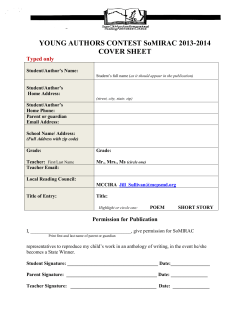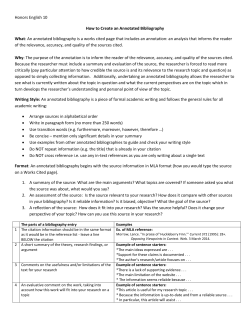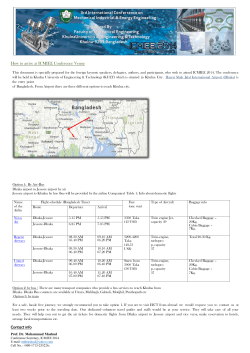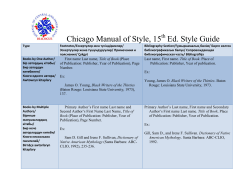
SAMPLE SESSIONAL REPORT 1.0 Abstract/Introduction:
KHULNA UNIVERSITY OF ENGINEERING & TECHNOLOGY Department of MECHANICAL ENGINEERING SAMPLE SESSIONAL REPORT 1.0 Abstract/Introduction: Here summarize four essential aspects of the report: o o o o The purpose of the experiment (sometimes expressed as the purpose of the report), Key findings, Significance and Major conclusions. The abstract often also includes a brief reference to theory or methodology. The information should clearly enable readers to decide whether they need to read your whole report. The abstract should be one paragraph of 100-200 words. The Abstract is a miniature version of the lab report. Using any type of figures or tables or equations here is prohibited. 2.0 Objectives: Write down the objectives of the experiment point by point as (I) (II) (III) 3.0 Materials & Equipment: It can usually be a simple list, but make sure it is accurate and complete. Write down all the equipment’s and specimen/raw materials that is used to perform the experiment. 3.1 Materials: (I) (II) 3.2 Equipment: (I) (II) 4.0 Methodology: 4.1 Theory: It includes all theories and hypothesis that are used in the experiment. Rules and laws that is used to get the result. All figure should be named specifically beneath the figure as Figure 1, Figure 2, and Figure 3. Equations must be referenced as ℎ𝐿 = (𝑉1 −𝑉2 )2 2𝑔 --- (1) (N.B: The name of the book/Paper/Journal/Internet from where the equation is cited here should be provided in the reference section as 1.) 5.0 Experimental Data: 5.1 Data: All experimental data should be provided here with sufficient tables. Tables should be specified by their relevant name in the top of the table. (Such as Table 1; Table 2.) 5.2 Calculation: All calculations should be given here with necessary laws that already have been provided in the methodology section. 6.0 Result Interpretation & Discussion: 6.1 Result Interpretation: These are usually dominated by calculations, tables and figures; however, you still need to state all significant results explicitly in verbal form, for example: Using the calculated lattice parameter gives, then, R = 0.1244nm. Graphics need to be clear, easily read, and well labeled (e.g. Figure 1: Input Frequency and Capacitor Value). An important strategy for making your results effective is to draw the reader's attention to them with a sentence or two, so the reader has a focus when reading the graph. In most cases, providing a sample calculation is sufficient in the report. 6.2 Discussion: It is the most important part of your report, because here, you show that you understand the experiment beyond the simple level of completing it. Explain. Analyze. Interpret. Some people like to think of this as the "subjective" part of the report. By that, they mean this is what is not readily observable. More particularly, focus your discussion with strategies like these: Compare expected results with those obtained. Analyze experimental error. Explain your results in terms of theoretical issues. Relate results to your experimental objective(s). Compare your results to similar investigations. Analyze the strengths and limitations of your experimental design. 7.0 Conclusion: It can be very short in most undergraduate laboratories. Simply state what you know now for sure, as a result of the lab. Generally, this is enough; however, the conclusion might also be a place to discuss weaknesses of experimental design, what future work needs to be done to extend your conclusions, or what the implications of your conclusion are. 8.0 Reference: This is a list of the references that were cited in the lab report, including the lab manual, any handouts accompanying the lab, the textbook, and sources from the scientific literature. The format for references differs in different fields and even within the same field. It's important that you check with you teacher or lab manual to find out what is expected of you. As in order: Author name, Book name, Publication name, Place of publication, year of publication Example: 1. Modi, Dr. P.N. and Seth, Dr. S.K., “Hydraulics and Fluid Mechanics Including Hydraulic Machines (In SI Units)”, Standard Book House, Nai Sarak, Delhi-110006 (India), New Edition, 2005-2006. 2. Bentley, J., “Principles of Measurement Systems”, NewYork, Longman: Scientific and Technical (1988). (e.g.: So the equation ℎ𝐿 = (𝑉1 −𝑉2 )2 2𝑔 is available in the book of P.N Modi) Prepared by Engr. A.H.M Fazle Elahi Lecturer Department of Mechanical Engineering Khulna University of Engineering & Technology (KUET) Khulna-9203; Bangladesh Phone: +880-41-769471 (Ext: 425) (Off) Mobile: +880-1912-239243 email: fazle.elahi.ashek@gmail.com;fazleelahi@me.kuet.ac.bd; web: http://www.kuet.ac.bd/me/fazleelahi
© Copyright 2025





















